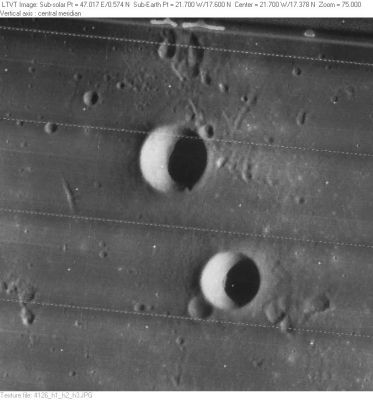Difference between revisions of "Draper"
| Line 6: | Line 6: | ||
|} | |} | ||
<div id="toc"> | <div id="toc"> | ||
| − | [http://www.lpod.org/coppermine/albums/userpics/Draper_LO-IV-126H_LTVT.JPG [[Image: | + | [http://www.lpod.org/coppermine/albums/userpics/Draper_LO-IV-126H_LTVT.JPG [[Image:Normal_Draper_LO-IV-126H_LTVT.JPG|external image normal_Draper_LO-IV-126H_LTVT.JPG]]]<br /> ''[http://lpod.org/coppermine/displayimage.php?pos=-2583 LO-IV-126H]'' '''Draper''' is the upper of the two craters, with 8-km '''Draper C''' below it.<br /> <br /> |
==Images== | ==Images== | ||
[http://www.lpod.org/coppermine/thumbnails.php?album=search&type=full&search=Draper LPOD Photo Gallery] [http://www.lpi.usra.edu/resources/lunar_orbiter/bin/srch_nam.shtml?Draper%7C0 Lunar Orbiter Images] [http://www.lpi.usra.edu/resources/apollo/search/feature/?feature=Draper Apollo Images]<br /> - Although not mentioned in the LPI's Apollo Image Atlas, the ''Fairchild'' metric-mapping camera of Apollo 17 made interesting photographs of the '''Draper pair''' too. These frames are detectable in [http://www.lpi.usra.edu/resources/apollo/catalog/metric/revolution/?AS17R65 REV 65], of which frame [http://www.lpi.usra.edu/resources/apollo/frame/?AS17-M-2444 AS17-M-2444] shows both '''Draper''' and '''Draper C''' to the left of the frame's centre (the camera was looking southward, toward '''Copernicus''' near the horizon).<br /> - Two of Apollo 17's orbital ''Hasselblad'' camera photographs also captured the '''Draper pair''': frames [http://www.lpi.usra.edu/resources/apollo/frame/?AS17-139-21289 AS17-139-21289] and [http://www.lpi.usra.edu/resources/apollo/frame/?AS17-139-21290 21290].<br /> - Additional research orbital Apollo 17 photography: Danny Caes<br /> <br /> <br /> | [http://www.lpod.org/coppermine/thumbnails.php?album=search&type=full&search=Draper LPOD Photo Gallery] [http://www.lpi.usra.edu/resources/lunar_orbiter/bin/srch_nam.shtml?Draper%7C0 Lunar Orbiter Images] [http://www.lpi.usra.edu/resources/apollo/search/feature/?feature=Draper Apollo Images]<br /> - Although not mentioned in the LPI's Apollo Image Atlas, the ''Fairchild'' metric-mapping camera of Apollo 17 made interesting photographs of the '''Draper pair''' too. These frames are detectable in [http://www.lpi.usra.edu/resources/apollo/catalog/metric/revolution/?AS17R65 REV 65], of which frame [http://www.lpi.usra.edu/resources/apollo/frame/?AS17-M-2444 AS17-M-2444] shows both '''Draper''' and '''Draper C''' to the left of the frame's centre (the camera was looking southward, toward '''Copernicus''' near the horizon).<br /> - Two of Apollo 17's orbital ''Hasselblad'' camera photographs also captured the '''Draper pair''': frames [http://www.lpi.usra.edu/resources/apollo/frame/?AS17-139-21289 AS17-139-21289] and [http://www.lpi.usra.edu/resources/apollo/frame/?AS17-139-21290 21290].<br /> - Additional research orbital Apollo 17 photography: Danny Caes<br /> <br /> <br /> | ||
| Line 16: | Line 16: | ||
[http://en.wikipedia.org/wiki/Draper_(crater) Draper]<br /> <br /> | [http://en.wikipedia.org/wiki/Draper_(crater) Draper]<br /> <br /> | ||
==Additional Information== | ==Additional Information== | ||
| − | * Depth data from [[Kurt%20Fisher% | + | * Depth data from [[Kurt%20Fisher%20Crater%20Depths|Kurt Fisher database]] |
** Arthur, 1974: 1.74 km | ** Arthur, 1974: 1.74 km | ||
** Westfall, 2000: 1.74 km | ** Westfall, 2000: 1.74 km | ||
Latest revision as of 02:47, 16 April 2018
Contents
Draper
|
Lat: 17.6°N, Long: 21.7°W, Diam: 8 km, Depth: 1.74 km, Rükl: 20 |
LO-IV-126H Draper is the upper of the two craters, with 8-km Draper C below it.
Images
LPOD Photo Gallery Lunar Orbiter Images Apollo Images
- Although not mentioned in the LPI's Apollo Image Atlas, the Fairchild metric-mapping camera of Apollo 17 made interesting photographs of the Draper pair too. These frames are detectable in REV 65, of which frame AS17-M-2444 shows both Draper and Draper C to the left of the frame's centre (the camera was looking southward, toward Copernicus near the horizon).
- Two of Apollo 17's orbital Hasselblad camera photographs also captured the Draper pair: frames AS17-139-21289 and 21290.
- Additional research orbital Apollo 17 photography: Danny Caes
Maps
(LAC zone 40D3) LAC map Geologic map
Description
Description: Wikipedia
Additional Information
- Depth data from Kurt Fisher database
- Arthur, 1974: 1.74 km
- Westfall, 2000: 1.74 km
- Viscardy, 1985: 1.74 km
- From the shadows in LO-IV-126H, the east wall of Draper is up to 1,790 m above the floor. Draper C is 1,580-1,630 m deep.
- The shallow crater touching the southwestern rim of Draper C (south of Draper itself) is an interesting test-object for all sorts of telescopes.- DannyCaes Feb 2, 2014
Nomenclature
- Henry Draper (March 7, 1837 - November 20, 1882) was an American doctor and astronomer. Draper was one of the pioneers of the use of astrophotography. He took the first stellar spectrum in 1872 that showed absorption lines. He directed an expedition to photograph the 1874 transit of Venus, and was the first to photograph the Orion Nebula, on September 30, 1880.
- It might be interesting to include the biography of Charles Stark "Doc" Draper (1901-1987), American scientist and engineer (known as the "father of inertial navigation"). See also LPOD Moon Flight.
LPOD Articles
Bibliography
Henry Draper in the Sourcebook Project:
- On a Photograph of Jupiter's Spectrum, showing evidence of Intrinsic Light from that planet (American Journal of Science, 1880), see: Mysterious Universe, a handbook of astronomical anomalies (William R. Corliss, The Sourcebook Project, 1979).
